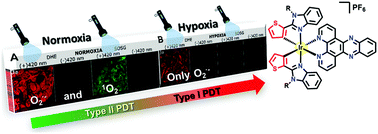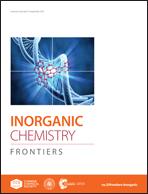Molecular superoxide radical photogeneration in cancer cells by dipyridophenazine iridium(iii) complexes†
Abstract
The phototoxicity in cancer cells of three series of octahedral Ir(III) complexes of the general formula [Ir(C^N)2(N^N)][PF6], where the N^N ligand is dipyrido[3,2-a:2′,3′-c]phenazine (dppz) and the C^N ligands are deprotonated 2-phenyl-, 2-(naphthalen-2-yl)- or 2-(thiophen-2-yl)-benzimidazole derivatives (series 1, 2 and 3, respectively) with different substituents (H, methyl or 4-(trifluoromethyl)benzyl) on the imidazole units, has been studied. The 1-methyl benzimidazole compounds 2b and 3b were found to be the most photoactive in model human cervical cancer HeLa cells (IC50 about 20 nM under irradiation conditions, λexc = 420 nm), inducing a substantial formation of apoptotic bodies as shown by flow cytometry, whereas the 4-(trifluoromethyl)benzyl derivatives 1c–3c showed the highest phototoxic indexes of the three series. Notably, the antiproliferative activity of the photoactivated Ir(III) compounds was also significant under hypoxic conditions (2% O2). Fluorescence confocal microscopy investigation for 1c, 2c and 3c was undertaken, showing a significant subcellular localization of 3c in mitochondria, whereas 1c and 2c were located preferentially in the endoplasmic reticulum (ER). Further investigations on series 3 compounds using CellRox® (oxidative stress deep red reagent) have shown, after pretreatment with Tiron, that molecular superoxide radical (O2˙−) generation is mainly responsible for the oxidative stress induced by irradiation of the cells treated with the 2-(thiophen-2-yl)benzimidazole derivatives 3a–c. The photopotentiation of 3a and 3c also involves the formation of singlet oxygen (1O2), but this does not occur with 3b, due to pretreatment with sodium azide. The ROS generation was also studied by standard droethidium (DHE) and singlet oxygen sensor green (SOSG) staining assays under both normoxic and hypoxic conditions. The results showed that in tumor HeLa cells, the generation of superoxide radicals competed with singlet oxygen production in cells in normoxia, but became dominant under hypoxia.



 Please wait while we load your content...
Please wait while we load your content...